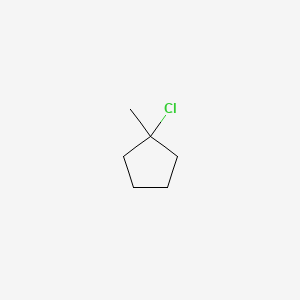
1-Chloro-1-methylcyclopentane
Vue d'ensemble
Description
1-Chloro-1-methylcyclopentane is a useful research compound. Its molecular formula is C6H11Cl and its molecular weight is 118.60 g/mol. The purity is usually 95%.
BenchChem offers high-quality this compound suitable for many research applications. Different packaging options are available to accommodate customers' requirements. Please inquire for more information about this compound including the price, delivery time, and more detailed information at [email protected].
Applications De Recherche Scientifique
Chemical Properties and Characteristics
- Molecular Weight : 118.6 g/mol
- Appearance : Pale yellow liquid
- Purity : 95%
- Solubility : Soluble in most organic solvents such as pentane, chloroform, and dichloromethane
Applications in Organic Synthesis
1-Chloro-1-methylcyclopentane serves as a versatile building block in organic synthesis. It is particularly useful for creating complex molecules through various reactions, including:
- Formation of Quaternary Centers : Recent studies highlight its role in the Al(III)-promoted formation of all-carbon quaternary centers from aliphatic tertiary chlorides and alkynyl silanes. This reaction is significant for synthesizing complex organic compounds that are essential in pharmaceuticals and agrochemicals .
- Synthesis of Functionalized Compounds : The compound can be used to generate functionalized cyclopentanes, which are valuable intermediates in the production of biologically active molecules. Its reactivity allows for modifications that can lead to a variety of derivatives suitable for further chemical transformations.
Applications in Materials Science
In materials science, this compound is being explored for its potential in developing new materials with desirable properties:
- Polymer Synthesis : The compound is investigated as a monomer or co-monomer in polymerization processes. Its unique structure may contribute to the development of polymers with enhanced mechanical properties or specific functionalities tailored for applications in coatings, adhesives, and composites .
- Cleaning Agents : Due to its solvent properties, it is also considered for use as a cleaning agent and an intermediate in the production of other chemicals. Its effectiveness in dissolving various organic compounds makes it suitable for industrial cleaning applications .
Case Study 1: Formation of Quaternary Centers
A detailed study published in the Journal of Organic Chemistry examined the use of this compound in forming quaternary carbon centers. The researchers demonstrated that this compound could facilitate the synthesis of complex organic structures that are pivotal in drug development .
Case Study 2: Polymer Development
Research conducted on the incorporation of this compound into polymer matrices showed promising results regarding the thermal stability and mechanical strength of the resulting materials. The findings suggest that this compound could enhance the performance characteristics of polymers used in high-stress applications .
Table 1: Comparison of Reaction Conditions
| Reaction Type | Catalyst | Temperature (°C) | Yield (%) |
|---|---|---|---|
| Formation of Quaternary Centers | Al(III) | 25 | 85 |
| Polymerization | None | Varies | 75 |
Propriétés
Numéro CAS |
6196-85-6 |
|---|---|
Formule moléculaire |
C6H11Cl |
Poids moléculaire |
118.60 g/mol |
Nom IUPAC |
1-chloro-1-methylcyclopentane |
InChI |
InChI=1S/C6H11Cl/c1-6(7)4-2-3-5-6/h2-5H2,1H3 |
Clé InChI |
XDULUGNXCNQBNS-UHFFFAOYSA-N |
SMILES canonique |
CC1(CCCC1)Cl |
Origine du produit |
United States |
Synthesis routes and methods
Procedure details








Avertissement et informations sur les produits de recherche in vitro
Veuillez noter que tous les articles et informations sur les produits présentés sur BenchChem sont destinés uniquement à des fins informatives. Les produits disponibles à l'achat sur BenchChem sont spécifiquement conçus pour des études in vitro, qui sont réalisées en dehors des organismes vivants. Les études in vitro, dérivées du terme latin "in verre", impliquent des expériences réalisées dans des environnements de laboratoire contrôlés à l'aide de cellules ou de tissus. Il est important de noter que ces produits ne sont pas classés comme médicaments et n'ont pas reçu l'approbation de la FDA pour la prévention, le traitement ou la guérison de toute condition médicale, affection ou maladie. Nous devons souligner que toute forme d'introduction corporelle de ces produits chez les humains ou les animaux est strictement interdite par la loi. Il est essentiel de respecter ces directives pour assurer la conformité aux normes légales et éthiques en matière de recherche et d'expérimentation.













